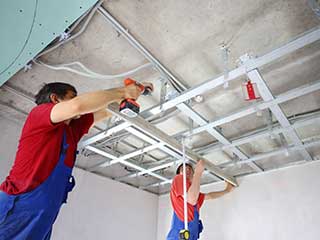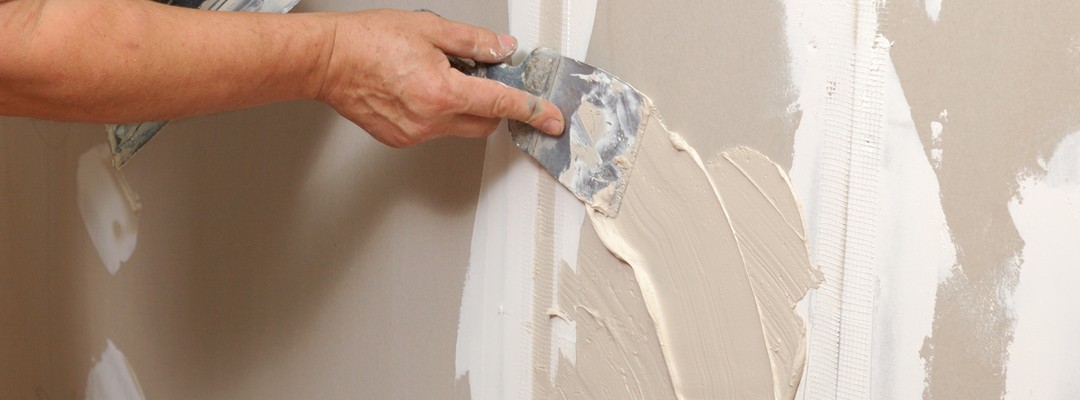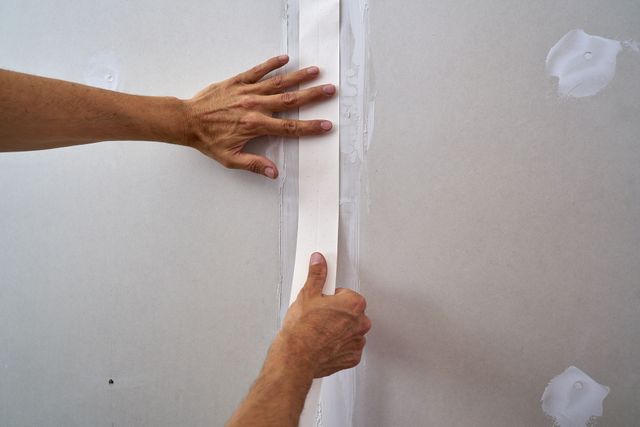Step-by-Step Approaches to Achieving Flawless Drywall Repair Work and Installation
Attaining perfect drywall repair and setup needs a systematic method. It includes recognizing the various kinds of drywall and the tools necessary for the job. Proper area preparation is important prior to starting any type of job. drywall contractor. Each step, from covering holes to mounting brand-new sheets, needs interest to information. The procedure doesn't end with setup; ending up methods are essential for a sleek appearance. The following steps will ensure a seamless outcome, however exactly what do they entail?
Comprehending Drywall Kind and Tools Needed

The setup tools are equally essential. An utility knife is crucial for cutting drywall sheets, while a drywall saw can assist in making specific cuts for fixtures or electrical outlets. T-squares ensure exact measurements, and drywall screws or nails protect the panels to wall studs. In addition, a drywall lift can promote the installment of huge sheets, reducing physical stress. Knowledge with these devices and types significantly adds to the effectiveness and quality of drywall projects.
Preparing the Area for Repair or Setup
Preparing the location for drywall repair or installation is vital to ensure a effective and smooth procedure. The surrounding space should be cleared of furnishings and various other barriers to supply enough working space. This not only ensures security but also prevents damages to personal belongings. Next off, it is important to cover the flooring with decrease cloths to capture any type of particles or dirt created throughout the work.
Furthermore, the walls must be examined for any kind of loosened paint or wallpaper that may disrupt adhesion. Getting rid of these aspects creates a clean surface for the new drywall. Prior to beginning, it is recommended to switch off power to electric outlets or fixtures in the location. Making certain appropriate lighting in the work space will further boost visibility and emphasis during the repair or installment process. drywall contractors. By carefully preparing the location, one lays the groundwork for a successful drywall task
Step-by-Step Refine for Patching Holes

Patching openings in drywall calls for an organized technique to ensure a seamless repair work. The initial step involves evaluating the size of the hole. For small holes, a patching compound may suffice, while larger holes require a patch. Next off, the damaged location must be cleansed and prepared by removing any kind of loose debris.
For tiny holes, applying spackling compound with a putty blade is recommended, smoothing it over the hole and feathering the sides. As soon as completely dry, fining sand the area ensures a smooth finish. For larger openings, a drywall spot need to be reduced to size, positioned over the hole, and safeguarded with screws. After mounting the spot, the exact same spackling process is read more repeated, adhered to by sanding.
The patched area must be topped and repainted to match the surrounding wall. This thorough process ensures an expert appearance and expands the life expectancy of the repair work.
Installing New Drywall Sheets: A Comprehensive Overview
Setting up new drywall sheets calls for cautious planning and implementation to assure a visually appealing and tough surface. Initially, the location must be gauged precisely to determine the variety of sheets needed. It is essential to choose the best density, usually 1/2-inch for indoor wall surfaces and 5/8-inch for ceilings or fire-rated applications.
Next off, the studs or structure should be inspected for any irregularities, ensuring they are aligned and correctly spaced. When placing the drywall sheets, they ought to be positioned horizontally to reduce seams and enhance architectural integrity. A drywall lift can be useful for above installations.
Fastening the sheets with drywall screws at appropriate intervals makes particular a protected installation. It is very important to countersink the screws slightly below the surface to get ready for the completing process. Adhering to these standards will lead to a solid foundation, ready for the next action in drywall finishing.
Ending Up Touches: Taping, Mudding, and Sanding Strategies
When the drywall sheets are securely fastened, the emphasis moves to the finishing touches that will certainly offer a polished look. This process begins with taping, making use of either paper or fiberglass harmonize tape to cover the joints in between sheets. The tape assures a smooth change, minimizing the danger of splitting. Complying with taping, mudding is crucial; a joint compound is applied over the tape to fill gaps and create a smooth surface area. Commonly, numerous layers are needed, each one feathered out additionally than the previous to lessen visibility.
After enough drying time, fining sand is the final action in achieving a perfect coating. A fine-grit sandpaper is utilized to smooth the dried out compound, ensuring there are no imperfections or bumps. Focus to information throughout this phase is substantial, as it considerably impacts the general look of the wall surface. The end outcome need to be an even, professional-looking surface area ready for priming and painting.
Regularly Asked Questions
Exactly how Do I Pick the Right Drywall Density for My Project?
To select the appropriate drywall thickness, think about the project's function, area, and structural requirements. Requirement densities consist of 1/2-inch for basic usage and 5/8-inch for fire-rated applications, guaranteeing resilience and compliance with structure codes.

Can I Install Drywall Over Existing Drywall?
Yes, installing drywall over existing drywall is possible. It is essential to assure the underlying surface is cost-free and secure from damages. Proper fastening and consideration of thickness are imperative for a successful installation.
What Are the most effective Practices for Drywall Disposal?
The very best methods for drywall disposal include recycling when possible, utilizing local waste management services, and complying with guidelines for dangerous materials if appropriate. Interior Painting. Effectively identifying and sealing waste guarantees compliance and safety and security throughout disposal
For how long Should I Wait for Mud to Dry Before Fining sand?
Normally, one ought to wait 24-hour for drywall mud to completely dry prior to fining sand. Drying time can differ based on humidity and temperature, so examining for a firm texture is suggested prior to proceeding.
Exist Eco-Friendly Drywall Options Available?
Yes, environment-friendly drywall choices are available. These choices commonly utilize recycled products, low-VOC adhesives, and sustainable production approaches, minimizing environmental effect while offering reliable insulation and longevity for different building and construction and restoration projects.
An energy knife is crucial for cutting drywall sheets, while a drywall saw can assist in making precise cuts for fixtures or electrical outlets. Preparing the location for drywall repair work or setup is important to ensure a effective and smooth procedure. Patching holes in drywall needs a methodical method to guarantee a smooth repair work. Mounting brand-new drywall sheets requires cautious preparation and execution to ensure a visually attractive and sturdy coating. Yes, mounting drywall over existing drywall is possible.